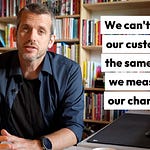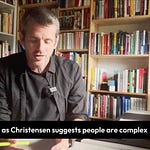Back in 2019 we travelled to Paris meeting a team that had done the work collecting streams of new, interesting and promising data. The team was sitting on a treasure trove. But they were unhappy, asking: “Why are we not coming up with any original ideas?” Listening to them throughout the day the reason dawned on us; because they kept asking all their new data the same old questions.
The questions we ask and the models we use to process our data into insights and answers is the difference between data as a commodity, something everyone has, and data as a competitive advantage.
It’s often the processing of the data not the data itself that makes a ton of difference.
Let me share two examples demonstrating how important the processing of information can be.
A. Finding new narratives in old insights
In one of our projects relating to medical professionals we didn’t have the opportunity to do new research. But with lots of available old research we simply re-processed it. We filtered away the researchers original narratives leaving us with the core data and the opportunity to look at it through new perspectives.
We found we could change the focus from people to situations (2) clearly seeing three situations with important insights.
In one situation information from commercial companies were not used or wanted. This was a situation where the industry was spending significant amounts of resources and huge efficiencies (3)(4) could be gained by reducing, automating or simplifying the efforts that went into the production of content (which due to other reasons still had to be produced).
We could also find two other significant situations where medical professionals were asking for more help and where a pharmaceutical company was a likely source of it. But we could see through the data that what medical professionals would value in these situations was not what the industry already assumed.
By looking at the data specifically through the lens of situations and needs we could identify motivators and desired outcomes that were not necessarily functional, but rather emotional and social. And that the situations as we had understood them led us to misunderstand what the medical professional was trying to achieve and what their desired outcomes were (5).
What’s important to recognize is both that while all data has value, getting to that value depends on the processing. And also if there is no time or budget to get new data or research, looking at old data through new perspectives can make a lot of difference.
While all data has value, getting to that value depends on the processing.
B. Changing the game entirely
Every model is a simplification of the world boiled down to its most essential parts. It’s an assumption of what we believe drives decisions, actions and events in real life.
e.g. if we use a customer journey we believe there is some kind of linear process a person has to experience in order for them to go from their starting point to a purchase. We also believe this process can be isolated and that the person who is on their path to becoming a customer cares about the world through the lens of what the company has drawn up.
There is an easy way to test if the model we’ve made is relevant to the people in it: ask if this is the lens through which they also see the world.
E.g. if we are using a customer journey, is what the customer cares most about their own progress through this journey towards the purchase?
Or: does a person buying a mattress care more about using the mattress or purchasing it?
In pharma a common model to use is the patient pathway, it’s like a customer journey but where the patient travels through a ‘treatment’ journey from symptom to diagnosis, treatment, monitoring, etc..
Our first issue with this model was that when we looked at external research (not from commercial companies) we couldn’t find a pharma product or pharmaceutical company anywhere in the pathway. We were not significant enough to be represented. This was an interesting insight.
In a separate project we therefore asked: what does treatment look like from a patient perspective?
What we found was ground breaking. Imagine if you’re a patient undergoing months long treatment from a mentally exhausting illness: what is the first thing that goes through your mind when you get up in the morning? What motivates you through the day? Which relationships influence you? What’s important?
Most likely it’s not the patient pathway, nor which stage you are on and where you will go next.
It’s something completely different.
We found that every day the patient wakes up with the same feelings, and that everything they engage with amplifies or dampens these feelings. That treatment is not a linear process, but a system of related parts designed so that they have a positive or negative influence on the patients mental health and treatment experience. And that if we would listen, we could see new things that could be done to improve that experience and potentially the treatment as well.
What we discovered not only changed how we understood the patient, but also what the role of the other actors (e.g. medical professionals) in the system are.
It doesn’t mean the patient pathway doesn’t exist or that there isn’t good insights to be made through that lens. But we demonstrated that there are more perspectives. And if every competitor is looking at the world through the lens of the patient pathway, they will most likely also be investing in the same things. While looking at the world through more perspectives creates the opportunity to see things others are not even aware of.
Summary
The perspectives we choose can mean the difference between delivering a commodity or breaking through with a competitive advantage.
It all relies less on the data we make available, and more on how we choose to process the data when asking questions and finding answers.
Sources and further reading:
(1). Paraphrasing Gary Hamel, source unknown
(2). Customers don’t buy products situations and needs do, https://medium.com/design-bootcamp/customers-dont-buy-products-situations-and-needs-do-520b5491f8d1
(3). Disrupting efficiency, https://medium.com/everything-new-is-dangerous/disrupting-efficiency-4ebea26dfcc5
(4). Your greatest cost cutter is the customer, https://medium.com/everything-new-is-dangerous/your-greatest-cost-cutter-is-the-customer-048e29e1e38f
(5). Tony Ulwick, Outcome-Driven Innovation: JTBD Theory in Practice, https://jobs-to-be-done.com/outcome-driven-innovation-odi-is-jobs-to-be-done-theory-in-practice-2944c6ebc40e
(6). Christian Madsbjerg, Look, https://madsbjerg.com/
(7). Stefan Thomke, Experimentation Works, https://www.hbs.edu/faculty/Pages/item.aspx?num=57045











